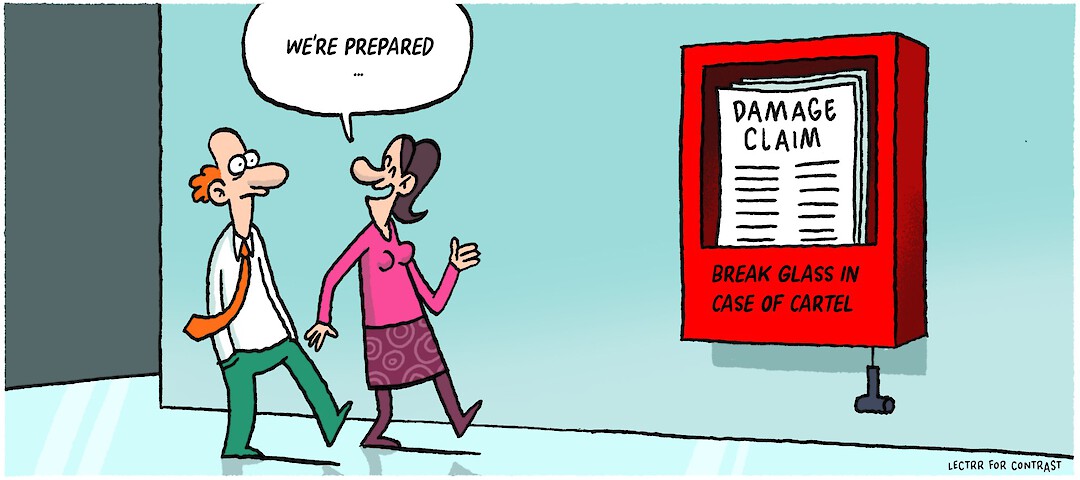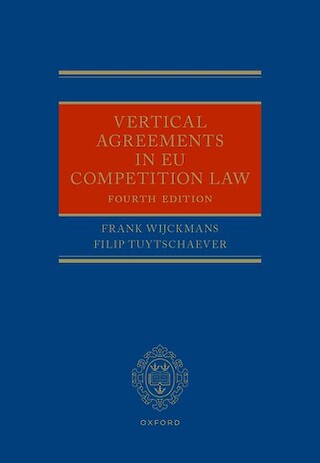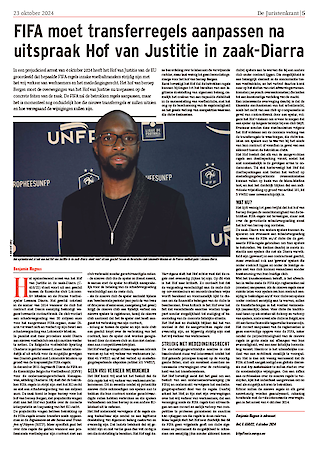In the Picture

Private damages actions – secure your position
April 2021Imagine…
Due to having worked at home so much, you forget your badge when you go to the office for the first time in months. Fortunately, the security guard remembers you and lets you into the building.
A little later you receive a newsflash on your phone – something about ´price fixing agreements´ and ´security firms´. Intrigued, you keep reading… It appears that the Competition Authority has started a large-scale investigation into possible restrictive practices in the security sector. A number of major players are said to have entered into price fixing and market sharing agreements. Apparently the professional association of the security sector was also involved. It strikes you that the news report pays a great deal of attention to those who were ´injured´ by these practices.
You immediately think of the guard who just let you into your office building. Was the security firm he works for also involved? Could your own company be an ´injured´ party as well? And what might your company be entitled to?
A brief clarification.
When am I an injured party? You are an injured party when you have suffered harm due to an infringement of competition law. Usually this means that you suffered harm because you paid too much as a result of this infringement (artificial price increase).
With security firms, this could involve a very wide range of injured parties. There are countless companies that call on the classic security services - just like your own company. But it can also involve consumers who have an alarm installation at home, or even the Belgian government.
As an injured party, what am I entitled to? Full compensation of your damage, i.e. the overcharge that you were wrongfully made to pay. You can try to reach a settlement with your supplier on this. If that does not succeed, you can file a claim before the national court (private damages action).
The legal landscape of private damages actions has changed significantly since an important European directive was adopted with the objective of enabling victims to more effectively recover their damage. This was transposed into national law three years ago by all EU Member States.
The basic principle remains that you, as an injured party, will have to demonstrate the fault (the competition law infringement), the existence and scope of the damage, as well as the causal relationship between the fault and the damage. The law facilitates the injured party’s task by providing for a number of presumptions, including the (rebuttable) presumption that cartel infringements cause harm. Thus, if there is a cartel infringement, the legislature now proceeds on the assumption that there will be damage. You will still have to demonstrate the scope of the damage.
What now? The Competition Authority has the people and the resources to conduct a thorough investigation. That might well take several years. If a competition law infringement is established (which remains to be shown), this will lead to a decision of the Competition Authority imposing a fine.
During the investigation, the prescription period is interrupted, so your damages claim cannot be prescribed before the infringement is established by the Competition Authority. This means that you do not have to take immediate action, but can instead await the outcome of the proceeding. But doing nothing at all is not recommended, either – there are a number of things you can already prepare.
For example, as a possibly injured party, you can gather all useful documents, such as contracts signed or payments made (invoices). Make sure that these documents do not go missing - and always go back far enough into the past. After all, a cartel often extends over a number of years. It is not uncommon for the Competition Authority’s decision to go back an entire decade.
Furthermore, prepare yourself as well as possible for the defence that the infringers are likely to raise. For example, they often try to demonstrate that you were able to pass on the additional cost to your own customers, and so in fact you suffered no damage - this is called the “passing-on” defence. For you to be able to rebut that defence, you should collect and preserve documentation on your own cost calculations.
During the proceeding before the national court, you will in turn be able to demand access to specific relevant evidence that is in the hands of the infringers.
Finally, it can be useful to seek contact with the infringers once the investigation has advanced to a certain point, in order to explore a possible settlement. Not only do injured parties see their damage compensated more quickly as a result, the settlement will sometimes also be regarded as a mitigating circumstance when the infringer’s penalty is being determined. The legislation also generally provides for a suspension of the prescription period while settlement is being sought.
Concretely:
- You are an injured party when you have suffered harm caused by a competition law infringement.
- As a victim, you are entitled to full compensation.
- In a private damages action you will have to demonstrate the fault, the existence and scope of the damage, as well as the causal relationship between the fault and the damage. You can hereby rely on certain presumptions that are now inscribed in the legislation.
- Already document as much as possible your relationship with the possible infringers, including your own cost calculations. Moreover, go back far enough into the past. Make sure that these documents are carefully preserved.
- Approach the infringers in good time - given that reaching settlement can offer advantages for both parties.
Want to know more?
- Directive 2014/104/EU on certain rules governing actions for damages under national law for infringements of the competition law provisions of the Member States and of the European Union: https://eur-lex.europa.eu/legal-content/NL/TXT/PDF/?uri=CELEX:32014L0104&from=EN.
- Directive 2014/104/EU is transposed into Belgian law by means of the articles XVII.71 through XVII.91 of the Code of Economic Law.
- For a discussion of the regime for actions for damages in Belgium, see the contribution of F. Wijckmans, M. Visser, K. Francken, M. Sengeløv and M. Wilson in The Private Competition Enforcement Review 2020 (The Law Reviews, Ilene Knable Gotts and Kevin S Schwartz (eds)), https://thelawreviews.co.uk/title/the-private-competition-enforcement-review/belgium
- F. Wijckmans, M. Visser, S. Jaques and E. Noël, The EU Private Damages Directive, Practical Insights, Intersentia 2016.
- The ´In the Picture´ of June 2019, ´How much were my cartel damages, again?´, deals with the damage calculation in private actions for damages.
You have just read the 50th ‘In the Picture’. If you have not yet subscribed, you can do so here. As a subscriber, you also have a chance to win a free copy of the ‘contrast competition codex’, ‘The EU Private Damages Directive - Practical Insights’ or ‘Share Purchase Agreements - Belgian Law and Practice’. Share this page with contacts you think might also be interested in ‘In the Picture’, and be sure to give them your personalised code(*). Each new subscriber you steer our way will give you an additional chance of being selected when we draw five winners at random after April 30th. Each winner will receive one of the above-mentioned books of his or her choice.
(*) Your personalised code is [contrastXFirstnameLastname], for example “contrastXElonMusk”.











